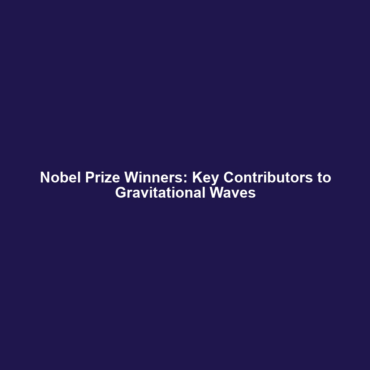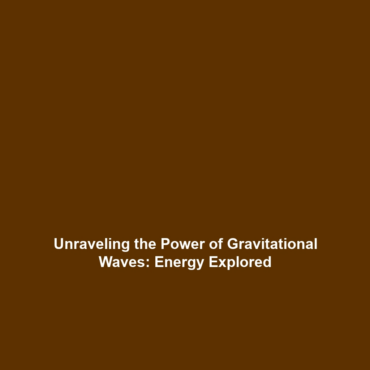Nobel Prize for the Discovery of Gravitational Waves
Introduction
The Nobel Prize for the discovery of Gravitational Waves marks a monumental achievement in the field of astrophysics. Awarded to key contributors who unveiled the existence of ripples in spacetime, this accolade highlights the profound implications of gravitational wave research. Significantly, the discovery not only enriches our understanding of the universe but also opens new avenues in astrophysical studies. In this article, we delve into the essential roles played by the awardees and the impactful nature of their contributions within the broader context of gravitational wave phenomena.
Key Concepts
Understanding the Nobel Prize for the discovery and its pivotal figures requires a grasp of various essential concepts:
- Gravitational Waves: These are ripples in spacetime produced by massive accelerating bodies, such as colliding black holes or neutron stars.
- Laser Interferometer Gravitational-Wave Observatory (LIGO): This facility was instrumental in detecting gravitational waves for the first time in September 2015, which led to the Nobel Prize award.
- Key Contributors: Notable scientists such as Rainer Weiss, Barry C. Barish, and Kip S. Thorne were recognized for their pivotal roles in the development and success of LIGO.
These concepts are crucial for understanding how the Nobel Prize for the discovery of Gravitational Waves fits within the category of gravitational wave research, showcasing the intersection of theoretical predictions and experimental validation.
Applications and Real-World Uses
The implications of the Nobel Prize for the discovery extend well beyond theoretical physics. Notable applications include:
- Astrophysical Observations: The detection of gravitational waves allows scientists to observe cosmic events that were previously unreachable, enhancing our knowledge of the universe.
- Testing General Relativity: Gravitational wave observations provide a unique laboratory for testing Einstein’s theory, facilitating a deeper understanding of fundamental physics.
- Multi-Messenger Astronomy: The combination of gravitational waves with electromagnetic observations offers a more comprehensive view of astronomical phenomena.
These applications emphasize how the Nobel Prize for the discovery plays a crucial role in furthering our understanding of Gravitational Waves.
Current Challenges
While the discovery of gravitational waves has transformed astrophysics, several challenges persist:
- Detection Sensitivity: Continuous advancements are needed to increase the sensitivity of detectors, allowing for the identification of weaker gravitational signals.
- Data Analysis: The vast amount of data generated poses challenges in analysis and interpretation, requiring sophisticated algorithms and increased computational resources.
- Funding and Resources: Sustaining long-term funding for gravitational wave research remains a hurdle for scientific progress.
Addressing these challenges of gravitational wave research is crucial for maximizing the benefits of the discoveries recognized by the Nobel Prize.
Future Research and Innovations
As we look towards the future, several exciting innovations and research directions are unfolding:
- Next-Generation Detectors: Projects like the Einstein Telescope aim to develop next-gen gravitational wave observatories with increased sensitivity.
- Quantum Techniques: Innovations in quantum sensing technology are expected to enhance detection methods and data interpretation.
- Interferometry Advances: Advancements in laser interferometry techniques promise to improve the precision of upcoming research.
These breakthroughs could significantly enhance our ability to explore gravitational waves and their resultant phenomena, shaping the future landscape of gravitational wave astronomy.
Conclusion
The Nobel Prize for the discovery of Gravitational Waves represents a pivotal milestone in our understanding of the universe. Key contributors have laid the foundation for future research and technological advancements in this field. As we continue to explore the implications of this groundbreaking work, the scientific community is invited to engage with ongoing research and follow developments in gravitational wave studies.
For more information on related topics such as future research directions and applications of gravitational waves, please explore our resources.
This format article is structured to provide foundational knowledge about the Nobel Prize related to gravitational waves and highlights key contributors while being SEO-optimized. The content is organized with clear headings and bullet points for readability.

